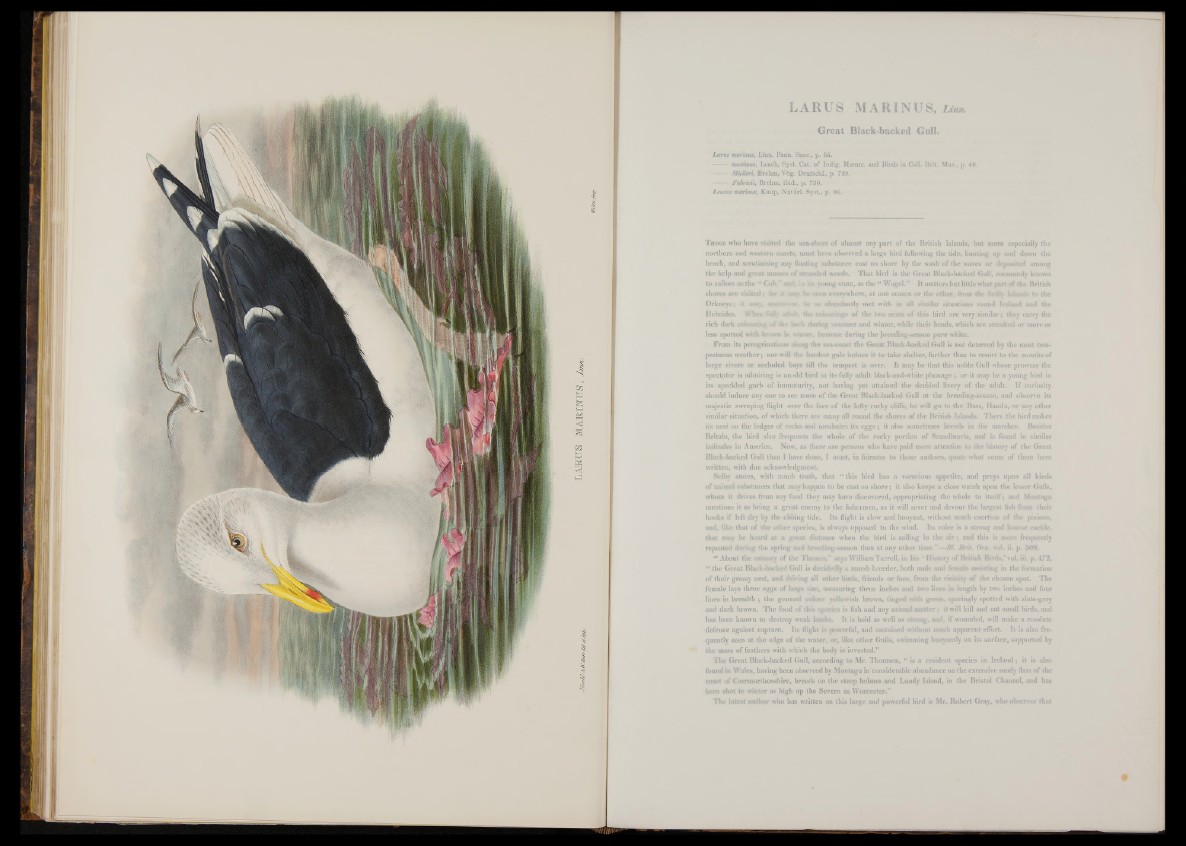
Great Black-backed Gull.
Lartiß maritim, Linn. Faun. Suec., p. 55.
ä ! s « ü i, Leach, Syst. Cat. of Indig. Maram. and Birds in Coll. Brit. Mus., p. 40.
— Mülleri, Brehm, Vög. Deutschl., p. 729.
Fabricii, Brehm, ibid., p. 730.
Leucus marinus, Kaup, Natiirl. Syst., p. 86.
T hose who have visited the sea-shore of almost any part of the British Islands, but more especially the
northern and western coasts, must bave observed a large bird following the tide, hunting up aud down the
beach, and scrutinizing any floating substance cast on shore by the wash o f the waves or deposited among
the kelp and great masses of stranded weeds. That bird is the Great Black-backed Gull, commonly known
to sailors as the “ Cob,’ awb its young state, as the “ Wagel.” It matters but little what part o f the British
shores are visited ; for rt uMf W ««en everywhere, at one season or the other, from the SeiUy Islands to the
Orkneys; it. may, fee as abundantly met with in all similar situations round Ireland and the
Hebrides. When Paß) adtdt, the eolotmngB o f the two sexes of this bird are very similar ; they carry the
rich dark cokwnrmg o f the back during '•»miner and winter, while their beads, which are streaked or more or
less spotted with brown in winter, become during the jjreeding-season pure white.
From its peregrinations along the sea-coast the Great Black-backed Gull is not deterred by the most tempestuous
weather; nor will the hardest gale induce it to take shelter, further than to resort to the mouths of
large rivers or secluded bays till the tempest is over. It may be that this noble Gull whose prowess the
spectator is admiring is an old bird in its fully adult black-and-white plumage ; or it may be a young bird in
i t s . speckled garb o f immaturity, not having yet attained the decided livery o f the adult. I f curiosity
should induce any one to see more o f the Great Black-backed Gull at the breeding-season, and observe its
majestic sweeping flight over the face o f the lofty rocky cliffs, he will go to the Bass, Hand a, or any other
similar situation, o f which there are many all round the shores ô£ the British Islands. There the bird makes
its nest on the ledges o f rocks and iucubates its eggs ; it also sometimes breeds in the marshes. Besides
Britain, the bird also frequents the whole o f the rocky portion o f Scandinavia, and is found in similar
latitudes in America. Now, as there are persons who have paid more attention to the history o f the Great
Black-backed Gull than I have done, I must, in fairness to those authors, quote what some o f them have
written, with due acknowledgment.
Selby states, with much truth, that “ this bird has a voracious appetite, and preys upon all kinds
of animal substances that may happen to be cast on shore ; it also keeps a close watch upon the lesser Galls,
whom it drives from any food they may have discovered, appropriating the whole to itself ; and Montagu
mentions it as being a great enemy to the fishermen, as it will sever and devour the largest fish from their
hooks if left dry by the ebbing tide. Its flight is slow and buoyant, without much exertion o f the pinions,
and, like that o f the other species, is always opposed to the wind. Its voice is a strong and hoarse cackle,
that may be heard at a great distance when the bird is sailing iu the air ; and this is more frequently
repeated during the spring and breeding-season than at any other t i m e Brit. Orn. vol. ii. p. 508.
“ About the estuary o f the Thames,” says William Yarrell, in his * History of British Birds/ vol. iii. p. 472,
“ the Great Black-hacked Gull is decidedly a marsh breeder, both male and female assisting in the formation
o f their grassy nest, and driving all other birds, friends or foes, from the vicinity o f the chosen spot. The
female lays three eggs o f large size, measuring three inches nud two lines ha length by two inches and four
lines in breadth ; the general colour yellowish brown, tinged with green, sparingly spotted with slate-grey
and dark brown. The food o f this species is fish and any animal matter ; it will kill and eat small birds, and
has been known to destroy weak lambs. It is bold as well as strong, and, if wounded, will make a resolute
defence against capture. Its flight is powerful, and sustained without much apparent effort. It is also frequently
seen at thé edge o f the water, or, like other Gulls, swimming buoyantly on its surface, supported by
the mass o f feathers with which the body is invested.”
The Great Black-backed Gall, according to Mr. Thomson, “ is a resident species in Ireland ; it is also
found in Wales, having been observed by Montagu in considerable abundance on the extensive sandy flats o f the
coast o f Caermartlienshire, breeds on the steep holmes and Lundy Island, in the Bristol Channel, and has
been shot in winter as high up the Severn as Worcester.”
The latest author who has written on this large and powerful bird is Mr. Robert Gray, who observes that